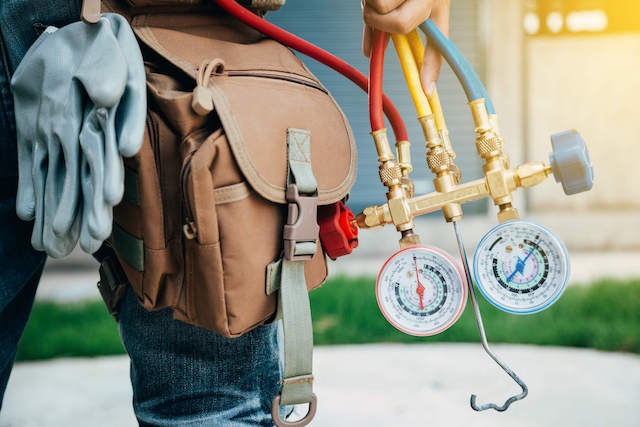Fall is in the air! It’s the time of year for bonfires, apple picking, and all things pumpkin. Seriously, how many more pumpkin-flavored and scented things can there be… And that’s not even considering all of the fall-themed home decor! For many, this chillier weather season is one of the best times of the year. It’s also a phenomenal time to focus on steps to prevent mold in the fall.
Chances are, actively working to prevent mold in the fall probably wasn’t high up on your list of autumn-inspired activities. But with the weather rapidly changing and the cold winter months ahead, it’s essential to focus on prepping your home so that water damage and indoor contaminants don’t wreak havoc on your indoor space and health.
Taking steps now can help add a layer of protection to your indoor environment so you can enjoy the upcoming holiday season. No one wants to deal with issues like mold growth and leaky attics when it’s colder than a polar bear's toenail. Plus, it takes away from the Halloween and Thanksgiving excitement!
Here are the top 6 tips to improve your home health this fall.
1. HVAC Service Appt to Prevent Mold in the Fall

Before changing from AC to heat, schedule an HVAC technician to come out and service your system to ensure it’s running properly and not contaminated. This individual will test for mold to ensure that when you switch your unit, you’re not blowing moldy particles throughout your home, creating a huge contamination situation. Condensation can build up in the unit with the temperature change, allowing hidden mold to begin growing. The technician should also clean the coil, make sure the blower, furnace, and cabinets are clean, and ensure that everything is operating correctly.
Piggybacking off of this, if it’s time to change those air filters, make sure you schedule in time to swap them out. It’s also important to upgrade to the highest-rated MERV filters possible for the specific unit so that it’s eliminating as many particles as possible from your air. The last thing you want is all of those particles to blast right back into your indoor environment.
2. Check For Structural Issues to Prevent Mold in the Fall
One of the key components to preventing mold in the fall is avoiding moisture from making its way indoors. The less moisture there is, the fewer opportunities there will be for mold growth. Ensuring the home's exterior is prepped to act as an appropriate barrier is a huge part of this push to avoid water intrusion. It’s particularly important before the winter months when moisture can expand in cracks and crevices, causing even more structural damage and creating a bigger opportunity for moisture to get in and begin wreaking havoc.
Before the ultra-chilly months set in, take a close look around your home to determine if there are any cracks, gaps, or other issues that could allow moisture inside.
Places to check include:
- Foundation
- Attic
- Roof
- Windowsills
- Door frames
- Siding
If you find any problems, take care of them ASAP so moisture intrusion does not occur. The sooner you can catch and resolve the problem, the better.
3. Maintain the Gutters to Prevent Mold in the Fall

As we all know, those colder temperatures are a green light for all of those beautifully colored leaves to fall everywhere. This seasonal occasion can wreak havoc on the health of our gutters, a rockstar protector against water damage.
Clogged and faulty gutters are one of the top problems that lead to moisture intrusion into a home and, as a result, mold growth. Cleaning them regularly during this debris-filled season, ensuring that they’re installed properly, and directing them away from the foundation of the home helps prevent water from intruding inside and causing mayhem. Consider a downspout extension if the fall weather in your local area is often accompanied by heavy rainfall.
Gutters in tip-top shape will help prevent water intrusion in your home and mold in the fall.
4. Assess the Fireplace to Prevent Mold in the Fall
Before lighting a fire during those chilly autumn nights, make sure to schedule a professional to come out and inspect the fixture. During the summer, the fireplace could have been blocked by debris or developed structural issues, leading to poor indoor air quality and possible water intrusion.
The person coming in should ensure that:
- The cap, crown, and flashing are in good condition and don’t have any damage that could allow moisture to enter
- There’s no debris blocking the chute
- The flu is operating correctly so that sooty air gets out
- The structural foundation of the chimney has no damage
- Any creosote, a harmful byproduct of burning wood, is removed
Collectively, this will ensure that your heat source is ready to rock and roll for the winter months and healthily help keep you and your family warm.
5. Open Doors and Windows for Ventilation to Prevent Mold in the Fall

There's very little airflow between indoor and outdoor environments thanks to modern building practices pushing for net-zero energy efficiency. That means that a majority of the particles that make their way inside will remain indoors until actions are taken to remove them.
During the summer months, windows and doors were most likely kept tightly closed to keep the indoor air cool and the AC bill as low as possible. As a result, all of those particles were able to build up inside. Deep cleaning and air purification can help to remove them, but working on ventilation is also a great step. When the air is cool, turn off the HVAC system and bust open those windows and doors to allow fresh air in. This will help replace the potentially particle-filled indoor air with fresh outdoor air.
After a couple of hours, close everything back up and jump into deep cleaning to remove any spores, bacteria, and mycotoxins hanging around. Make sure to blast your air purifier as well to eliminate any particles kicked up while cleaning and further help to prevent mold in the fall.
6. Work to Eliminate Dust to Prevent Mold in the Fall
Microscopic particles settle where dust settles. So all those door frames, shelves, baseboards, furniture, and other surfaces are covered in dust? Chances are that particles like mold spores, mycotoxins, and bacteria are hanging out as well. Sure, spring cleaning is great, but fall cleaning is just as beneficial!
Regular dusting can help to reduce the number of particles that can get kicked up into the air when the surface is disturbed. HEPA vacuum cleaners and microfiber towels are two tools that should be in your cleaning arsenal to help eliminate these particles from your home. The fewer particles there are on the home's surfaces, the cleaner the air and your indoor space will be.
If you’re concerned about what exactly is in your dust and if it could indicate a problem in the home, consider investing in a tool such as The Dust Test. This revolutionary product can help to identify what’s in a home so that you can have peace of mind that your indoor space is supporting your health or validate that your home is causing wellness problems.
Get Your Fall On

Adding this checklist to your fall weather activity extravaganza can help ensure your autumn season is backed by a healthy indoor environment. No one wants to deal with chronic symptoms triggered by exposure to indoor contaminants in their home. It not only puts a damper on the festivities, but it can also add a serious dent to the wallet.
Home health should always be a top priority for any wellness plan. So as you’re jumping into fall-i-fying your home, make sure to check off a few of the prevention steps above! Your home and your health will thank you.

